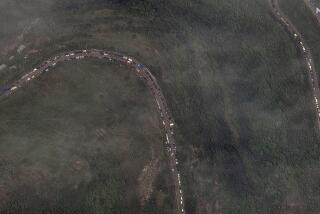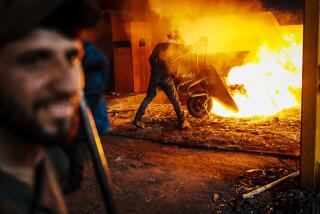Another Inning of the Great Game : AFGHANISTAN : The Great Game Revisited, <i> edited by Rosanne Klass (Freedom House: $29.95, cloth; $19.95, paper; 520 pp.) </i>
- Share via
The title of the book, “Afghanistan--The Great Game Revisited,” clearly reveals its premise: that the present conflict in Afghanistan is the historical continuation of czarist Russian and later Soviet attempts to reach a warm-water port. The Great Game, a term popularized by Rudyard Kipling in the novel, “Kim,” refers to the struggle between czarist Russia and the British in India for control and influence in Central Asia. Most of the authors of the scholarly papers in this book, including editor Rosanne Klass, see the Soviet invasion of Afghanistan as the modern phase of the Great Game, and foresee a permanent Soviet presence there.
Klass, in her introduction, quotes Amir Abdur Rahman, king of Afghanistan from 1880-1901, citing his image of the “Russian policy of aggression” as an elephant: “Once he puts his weight there is no going back and no taking another step until he has . . . smashed everything that lies under it.” Klass herself, who has been involved with Afghanistan since a teaching stint there in the 1950s, writes, “The supposition that the Soviet Union has no permanent ambitions in Afghanistan is belied, directly or by implication, by data in almost every chapter of this book.”
The book does go a long way toward remedying an astonishing lack of information and media coverage on Afghanistan, which Klass quite rightly laments: “the international silence regarding that genocide is deafening.” These papers, covering a wide range of aspects of modern Afghanistan and the conflict with the Soviets, contain much useful information, though one suspects that most of the authors were chosen for their ideology as much as for their expertise. The essays are almost uniformly pessimistic, though Alexandre Bennigsen provides a breath of fresh air and hope in his discussion of the impact of the Afghan war on the Soviet Union’s 50 million Muslims.
Current indications of a possible Soviet withdrawal tend to undercut the book’s basic assumption, but some disturbing questions are raised which must be considered even if the Soviets do withdraw troops. One thorny issue is the reported Soviet annexation of the Wakhan, a strategic strip of land bordering Pakistan, China, and the Soviet Union. Another crucial consideration is the lack of representation of the Afghan Resistance in the U.N.-sponsored talks to decide the fate of Afghanistan.
The book’s greatest service is the publication of material that is not generally known, especially regarding Soviet colonial-style exploitation of Afghan natural resources. This is well documented in pieces by John F. Schroder Jr. with Abdul Tawab Assifi, and by M. Siddieq Noorzoy. These authors point out the historical Soviet interest in Afghan minerals, especially Afghan natural gas, which has long been piped directly to the Soviet Union, sold for well below market price, with meters on the Soviet side of the border. The authors posit that the Afghan economy is being made to bear a large part of the price of the war against its own people, and that Soviet interest in mineral resources is likely to continue even after a withdrawal.
Horrific human rights violations, including widespread torture and massacres of civilians, are documented by Barnett R. Rubin, who has extensively interviewed Afghan refugees in Pakistan and the West. Eminent Afghan scholar A. Rasul Amin recounts the frightening process of the attempted Sovietization of Afghanistan, including the airlifting of thousands of Afghan children to the Soviet Union for 10 years of education. Many of these children are very young, and most go involuntarily.
Events will soon show if the assumptions of the book are correct. A depressing, worst-case scenario is outlined by Yossef Bodansky, who seems to know Soviet intentions better than the Soviets themselves in his article, “Soviet Military Operations in Afghanistan.” Bodansky conjectures that a Soviet invasion of Iran and thrust toward Persian Gulf oil fields is imminent, that parts of Iran are under control of Soviet proxies, and that Pakistan’s fate is to be dismembered or destroyed. However, even Bodansky finally concedes that a permanent Soviet occupation of Afghanistan is not inevitable: “Afghanistan is not lost if-- but only if --Western assistance becomes more effective, and soon.”
Recent Soviet willingness to negotiate may indeed be a response to more effective U.S. aid, particularly Stinger anti-aircraft missiles, which have significantly increased the cost of the war to the Soviets by allowing the Resistance to down planes and the dreaded helicopter gunships. This, combined with internal developments and changes in the Soviet Union, may have tipped the balance.
“Afghanistan--The Great Game Revisited” is a useful reference that will guide the serious student of Afghanistan and Afghan-Soviet relations through the Byzantine world of Afghan politics and history, as long as the reader can filter fact from supposition. The essays are all part of the truth, just as in the proverb of the blind men describing an elephant (originally from the Persian-language poet Rumi), each describes a part of the truth, but all fail to integrate it into a picture of the whole.
What does emerge from this book is a portrait of a nation nearly destroyed by Soviet ambition and Western indifference. The late Ambassador Leon B. Poullada, formerly posted in Afghanistan as counselor for economic affairs in the 1950s, recounts a history of American rebuffs to Afghan requests for military and other aid, and Soviet willingness to step in to fill the breach. The lesson of this tragic history is that when and if the Soviets do withdraw from Afghanistan, American and international assistance in the physical and economic reconstruction of this war-torn land is a moral and strategic imperative.
More to Read
Sign up for our Book Club newsletter
Get the latest news, events and more from the Los Angeles Times Book Club, and help us get L.A. reading and talking.
You may occasionally receive promotional content from the Los Angeles Times.










